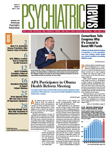Light therapy, the treatment of choice for seasonal affective disorder (SAD), may improve nonseasonal depression, bipolar disorder, pregnancy and postpartum depression, and other psychiatric disorders, new studies suggest.
Manipulations of the sleep/wake schedule also hold promise for correcting circadian rhythm disturbances common in such disorders, improving mood, cognition, and neurobehavioral function.
Specialists in chronotherapeutics—treatments aimed at resetting malfunctioning biological clocks—are stepping up efforts to educate other clinicians about these therapies, reported Michael Terman, Ph.D., a professor of clinical psychology in psychiatry and director of the Center for Light Treatment and Biological Rhythms at Columbia University College of Physicians and Surgeons in New York.
Light therapy remains both under-used and abused, Terman told Psychiatric News.
“Some clinicians tell patients to try a light box without knowing how to present and dose light therapy,” he said. “That often leads to treatment failure.”
Consumers who self-treat, using light boxes purchased on their own, he noted, may not get better and thus give up on therapy. Light devices, available from many suppliers, lack federal regulation.
Terman and colleagues established a nonprofit international organization in 1994 to foster education and research in chronobiology for professionals and patients. That organization, the Center for Environmental Therapeutics (CET), he asserted, “is a multidisciplinary academic department that could not exist at any university.”
The CET's Web site provides access to an automated morningness-eveningness questionnaire, a validated self-assessment tool that predicts the onset of melatonin secretion, a marker of time on the body's clock. The clinician needs to know when melatonin secretion starts, Terman said, to prescribe light at the right time to shift biological clocks earlier or later.
The CET has launched a Web site for clinicians, at<www.chronotherapeutics.org>, where a privacy-protected, moderated forum modeled on hospital rounds aims to promote discussion of complex cases and interaction with colleagues. This Web site also offers clinical assessment tools designed and produced at Columbia University's New York State Psychiatric Institute. These include structured interviews for rating the severity of depression and hypomania, sleep logs, and a questionnaire for monitoring possible adverse effects of light therapy.
In patients with bipolar disorder, sleep deprivation for a full night or only the second half of the night has been known for over 30 years to elicit a rapid antidepressant response, according to Francesco Benedetti, M.D., a professor of psychiatry at the University Vita-Salute San Raffaele and director of the psychiatry and clinical neurosciences research unit at San Raffaele Hospital in Milan, Italy.
Because most bipolar patients relapse after recovery sleep, sleep deprivation initially was not thought clinically useful, he said. Using repeated sleep deprivation—now called wake therapy—in combination with light therapy and lithium, however, he and colleagues have achieved sustained remission rates ranging from 50 percent to 75 percent, better than is expected with antidepressant medications, in hundreds of patients. Combination therapy also shortens hospitalization.
In both seasonal and nonseasonal depression, light and sleep manipulations may permit tapering or stopping antidepressant medications, noted Anna Wirz-Justice, Ph.D., an emeritus professor of psychiatric neurobiology at the Center for Chronobiology of the University of Basel in Switzerland. In pregnancy and postpartum depression, such therapies may serve as safe alternatives to antidepressant medications. Wirz-Justice is conducting a five-year double-blind, placebo-controlled trial of light therapy in major depression in pregnancy. Researchers also are exploring chronotherapeutics in attention-deficit/hyperactivity disorder, dementia, Parkinson's disease, and other disorders.
Wirz-Justice, Terman, and Benedetti are coauthors of a new book, Chronotherapeutics for Affective Disorders: A Clinician's Manual for Light and Wake Therapy.
The Society for Light Treatment and Biological Rhythms will hold its annual meeting June 24 to 27 in Berlin, Germany. The program is posted at<www.sltbr.org>. The Web address of the Center for Environmental Therapeutics is<www.cet.org>.▪
